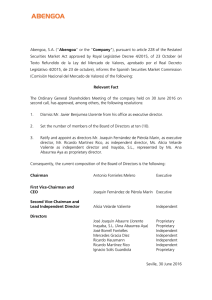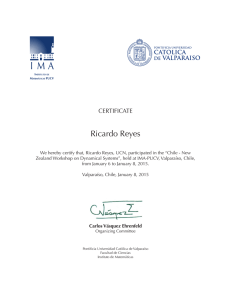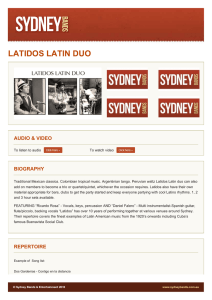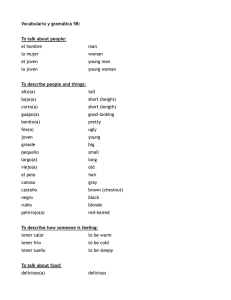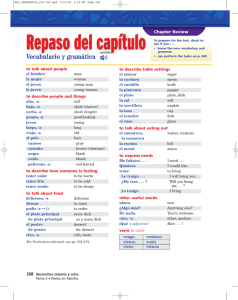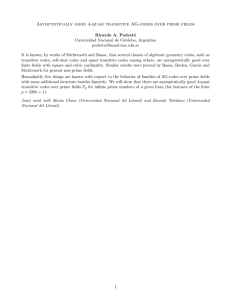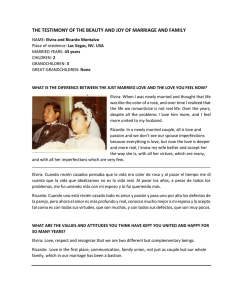• Learned everything about satellite reception on his own • Installs
Anuncio
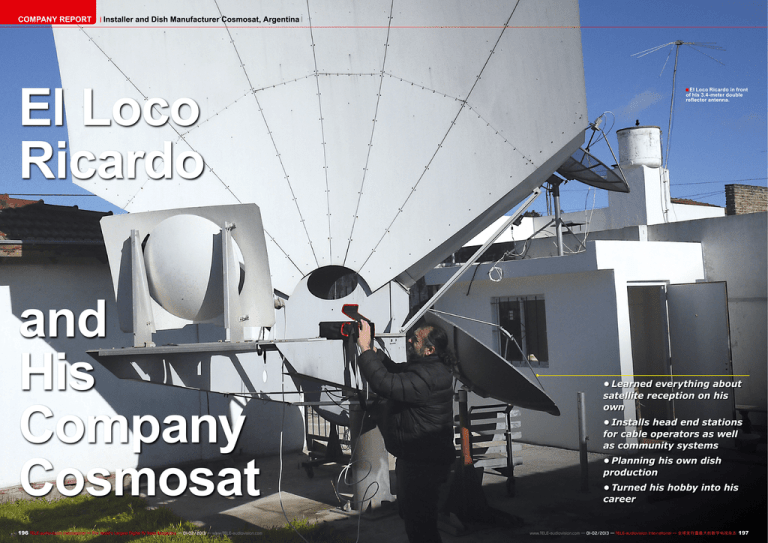
COMPANY REPORT Installer and Dish Manufacturer Cosmosat, Argentina El Loco Ricardo and His Company Cosmosat 196 TELE-audiovision International — The World‘s Largest Digital TV Trade Magazine — 01-02/2013 — www.TELE-audiovision.com ■ El Loco Ricardo in front of his 3.4-meter double reflector antenna. •Learned everything about satellite reception on his own •Installs head end stations for cable operators as well as community systems •Planning his own dish production •Turned his hobby into his career www.TELE-audiovision.com — 01-02/2013 — TELE-audiovision International — 全球发行量最大的数字电视杂志 197 COMPANY REPORT Installer and Dish Manufacturer Cosmosat, Argentina From DXer to Dish Producer Is this crazy or what? Ricardo has a professional 3.8-meter double-reflector dish installed in his yard and this includes a professionally cemented mounting platform. ‘Crazy’ in Spanish is ‘Loco’, hence his nickname “El Loco Ricardo”, and naturally this giant 3.8-meter dish isn’t his only antenna: he has a total of 11 antennas scattered around his property and on top of that there’s an uncountable number of other unconnected dishes of all different ë ■ Ricardo and extreme reception. He’s pointing the dish to EUTELSAT at 10°W. “I might be the only one that can receive this satellite here in Argentina.” 198 TELE-audiovision International — The World‘s Largest Digital TV Trade Magazine — 01-02/2013 — www.TELE-audiovision.com Buenos Aires ■ Ricardo in his reception shack. ■ Ricardo is using his hand to align to the right position. “Reception range spans from 116W to 10E”, comments Ricardo. sizes. Obviously, Ricardo isn’t crazy but he succeeded in converting his hobby into his career. He has been living and working in Itzuzaingo, a suburb west of Buenos Aires, since 2001. He explains to us how it all started: “I was 12 years old when my father moved to Colon in the Entre Rios province.” That was in 1977 and there was no TV reception there at all. So, what does an ambi- tious teenager do in a case like that? It’s simple: he builds and builds as long as needed until he’s able to receive TV from Rosario 300 km (190 miles) away. And the rest is history. Young Ricardo was infested with DX reception and started playing around with other frequency ranges. “Back then via shortwave I could hear every receivable station from around the world and I collected QSL cards from those stations.” When satellite channels started beaming down from the sky, Ricardo was one of the first in Argentina to try this new technology. He remembers: “I built my first satellite dish in 1985.” He needed almost a full year to build a 2.5-meter dish but the thrill of receiving that first TV channel was even greater. He still remembers today what ■ One of the standard homes as seen from the outside. Only if you look really close can you see the antenna hidden in the garden. 200 TELE-audiovision International — The World‘s Largest Digital TV Trade Magazine — 01-02/2013 — www.TELE-audiovision.com www.TELE-audiovision.com — 01-02/2013 — TELE-audiovision International — 全球发行量最大的数字电视杂志 201 1 2 1. Ricardo still has his first analog receiver stored in his shack: it’s a model from DX Antenna that he used to receive his first TV channel back in 1985. 2. Ricardo even has a bending machine in his workshop that he uses to bend mounts and attachments for dishes. 3. Ricardo’s homemade device for the reception of circularly polarized C-band signals. 4. In Cosmosat’s warehouse: Ricardo is very happy with the AZURESHINE dishes that he resells and also uses at his cable operator installations. 5. Also homemade: a Ku-band feedhorn. 3 those first TV channels were: “It was the cable TV channel VCC and its competitor CV. It was also the state-run Canal 7 and the just-started private TV channel Canal 9.” These four channels were on the INTELSAT V-F13 satellite. “I could also receive the channels on BRASILSAT A1 and GORIZONT.” It didn’t take long for him to realize that his 2.5-meter dish was too small for the C-band and in 1987 he was able to acquire a 3.4-meter antenna. The following year 1988 he began working for a living and started as a technician at a TV broadcaster. He soon realized that his fellow technicians and engineers were quite familiar with the theory but didn’t have all that much practical experience with reception. Ricardo on the other hand was always testing dishes and LNBs and knew exactly what size dish and what type of LNB was needed to receive a particular satellite. After installing satellite systems in his free time for years, he finally de- 5 4 202 TELE-audiovision International — The World‘s Largest Digital TV Trade Magazine — 01-02/2013 — www.TELE-audiovision.com www.TELE-audiovision.com — 01-02/2013 — TELE-audiovision International — 全球发行量最大的数字电视杂志 203 1 cided in 2004 to become independent: “I founded my own company Cosmosat (www.cosmosat-digital.com.ar). He focuses on installations, mostly for cable operators, and also on the installation of cable head ends and community systems. “In my first year I installed around 50 dishes, today it’s more than 200 a year.” In 2008 he expanded his activities to include the sale of components. “Some of these products I get from wholesalers and the others I import myself.” Far more interesting are his own creations. He shows us a Ku-band feed: “I designed this myself and have it manufactured here locally.” Another highlight of his handiwork is a C-band conduit for the reception of circular signals: “A friend of mine makes these for me here.” And it gets even more interesting: “I’m currently in the process of setting up a satellite dish fabrication plant.” The casting molds are already finished: “Right now I’m still experimenting with the right dish material.” Ricardo wants to start with the production of 1.5-meter dishes; larger sizes would come later. For his initial target market Ricardo is first looking at his home market in Argentina, “maybe later on I’ll consider exporting.” Ricardo has the know-how when it comes to how satellite dishes function and he knows best what size satellite dish is needed for a particular satellite. It’s valuable experience that will certainly help him market his dish production. Maybe ‘crazy’ Ricardo will soon become ‘dish’ Ricardo instead. 1. In a metal workshop of a friend Ricardo has a model of a panel that he had them build for him. He wants to start his own dish production here soon. 2. Ricardo’s yard is a treasure chest for old dishes and components. To the left is a professional rectangular antenna and to the right old framework for a 3.4-meter dish. “Over here I still have old framework for a 4.7-meter antenna.” In front of Ricardo’s feet sits an unusual microwave antenna with various reflectors and an interference radiation grid. Ricardo loves exotic antenna shapes like these. 2 204 TELE-audiovision International — The World‘s Largest Digital TV Trade Magazine — 01-02/2013 — www.TELE-audiovision.com ■ A look at some of Ricardo’s dishes. On the roof of his house you’ll find a 1.0-meter dish for TELSTAR 12, a 60cm antenna for GALAXY 28, an 80cm antenna for HISPASAT, a 1.5-meter reflector for AMC6 and a 100cm antenna for the AMAZONAS. An additional 1.8meter motorized dish sits on top of his reception shack. “A total of 11 dishes are mounted here and in operation.” 206 TELE-audiovision International — The World‘s Largest Digital TV Trade Magazine — 01-02/2013 — www.TELE-audiovision.com www.TELE-audiovision.com — 01-02/2013 — TELE-audiovision International — 全球发行量最大的数字电视杂志 207
